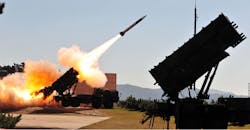The U.S. Army National Guard has selected Persistent Systems, LLC and its advanced MPU5 portable wireless radios for its Weapons of Mass Destruction Civil Support Teams (WMD-CSTs). The contract award is for more than 950 MPU5 smart radios and worth $8.9 million.
The radios are based on mobile ad hoc networking technology (MANET) and make it possible to establish high-speed networks anywhere at any time using multiple MPU5 radios. The radios use interchangeable frequency modules to cover different frequency ranges—including L-band from 1,350 to 1,390 MHz and S-band frequencies from 2,200 to 2,500 MHz—as well as multiple-input, multiple-output (MIMO) antenna technology.
The MPU5 radios and their MANET capabilities can instantly form self-healing radio networks without infrastructure. The radios can enter and leave the network, with automatic adjustments for changing nodes and reformation of the network configuration. The MPU5 radios also minimize the number of relay radios needed when dealing with physical obstacles and jammers/interference. They provide 6 W transmit power, enabling National Guard Civil Support Teams to network their sensors and transmit data collected in the field to a UCS vehicle and laboratory for analysis.
“MIMO radios thrive in urban environments, where standard radios have trouble,” Louis Sutherland, vice president of business development for Persistent Systems. “This enables the CST personnel to extend their network further from the truck and operate effectively in urban, high-population-density environments that are the most likely targets of an attack.”
The contract supports the U.S. Army’s Unified Command Suite (UCS) Program of Record, which is managed by the Joint Program Executive Office for Chemical Biological Defense (JPEO-CBD). The UCS program provides communications interoperability between military emergency response elements and federal, state, and local authorities during an incident of interest.
“Whether at a campaign rally or along a marathon route, National Guard Civil Support Teams run WMD detection operations to keep Americans safe,” Sutherland noted. “That’s why it is so important that they have a robust wireless network.”
About the Author
Jack Browne
Technical Contributor
Jack Browne, Technical Contributor, has worked in technical publishing for over 30 years. He managed the content and production of three technical journals while at the American Institute of Physics, including Medical Physics and the Journal of Vacuum Science & Technology. He has been a Publisher and Editor for Penton Media, started the firm’s Wireless Symposium & Exhibition trade show in 1993, and currently serves as Technical Contributor for that company's Microwaves & RF magazine. Browne, who holds a BS in Mathematics from City College of New York and BA degrees in English and Philosophy from Fordham University, is a member of the IEEE.


